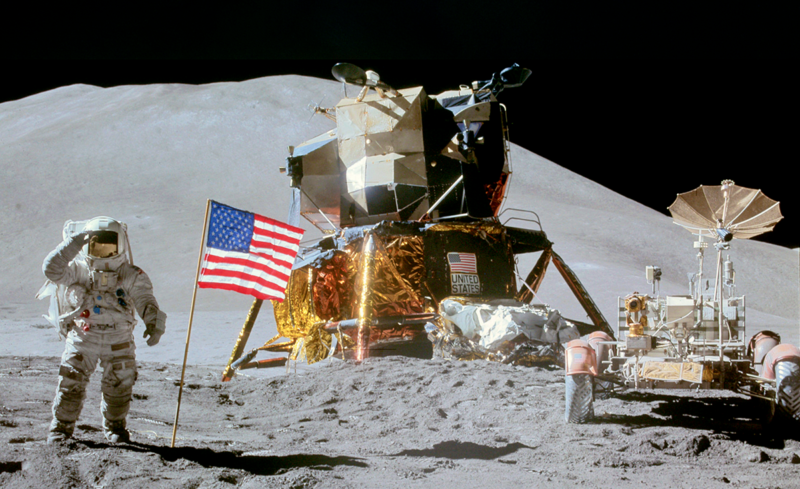Great Ideas
How math got us to the moon
And why teaching math the right way has never been more important
Fifty years ago this month, Neil Armstrong made history and in the process wowed the entire world with American scientific prowess.
This giant leap for mankind was achieved less than seven years since JFK laid out his bold vision for America’s space program. Trump now wants to plant the American flag on Mars — a laudable aim. But soaring presidential rhetoric won’t get us any nearer to Mars than it did the moon.
Math will.
“You can’t get anywhere without the numbers,” says John Glenn in the 2016 movie Hidden Figures. It’s an imagined line of dialogue but nevertheless true. We tend to remember the names of Glenn, Armstrong, Aldrin, and other astronauts. But it was the math brains behind the scenes — the hidden figures of the movie’s title — who made American spaceflight possible, first with Project Mercury and later with the moon landing. The film focuses on three of Mercury’s math pioneers — Katherine Johnson, Dorothy Vaughan, and Mary Jackson — who chartered a course both for space exploration and African-American participation in the US space program.
As the movie reminds us, America won the space race coming from behind. Russia scored the bragging rights for sending the first human into space when it launched Yuri Gagarin into orbit in April 1961. But after playing catch up, America eventually won the space race by putting a person on the moon.
Once again, America finds herself in a position of relative weakness. But this time it’s with math. Once a math superpower, America has slipped to an alarming 39 on the latest PISA rankings, an OCED measure of scholastic ability of 15-year-old students in 70 countries and territories. “Wake Up America, China is eating our lunch!” Trump loves to tweet. When it comes to math, it’s not just China dining at America’s expense. So is Singapore, Japan, South Korea, Switzerland, Estonia, Canada, Netherlands, Finland, Denmark, Slovenia, Belgium, Germany, Ireland, Poland, Norway, Austria, New Zealand, Vietnam, Australia, Sweden, Russia, France, United Kingdom, Portugal, Czech Republic, Italy, Iceland, Spain, Luxembourg, Latvia, Malta, Lithuania, Hungary, and Slovakia.
America faired better on the latest TIMSS rankings, a measure by the International Association for Evaluation of Educational Achievement (IEA) for math and science achievement of students in Grades 4 and 8. But it still didn’t make the top ten. Ahead of America are Singapore, Hong Kong, South Korea, Taiwan, Japan, Russia, Norway, Ireland, Belgium, Kazakhstan, and Portugal.
How has it come to this? More importantly, what can be done about it?
Well, to repurpose a phrase, we need to make math great again. And we can only do that by making math learning meaningful and enjoyable. Kids balk at math for the same reasons their parents did: they can’t relate to it and they don’t enjoy it.
It needn’t be this way.
That’s how we see it at ORIGO. Parrot teaching is great for birds but terrible for children. If math is to resonate with kids it has to be meaningful and enjoyable. The more relatable and fun kids find the learning experience, the more they’ll take in. It’s a simple proposition: the more meaningful it is and the more they enjoy it, the more they’ll learn.
This has to start in elementary. America will only improve her international math ranking among high-school students if those very same children have a solid conceptual understanding in math. You can’t launch a rocket without a launch pad.
ORIGO achieves this by infusing each and every one of our products with our four core beliefs: learning is a social process that requires language and discourse; students who develop strong thinking, problem-solving, and communication skills grow into productive, innovative members of society; content taught in a logical, coherent, and learner-friendly sequence inspires student engagement and success; and technology empowers rather than replaces educators.
Technology comes and goes. Presidents come and go. But “math is always dependable.” This is another line of imagined dialogue from Hidden Figures. This time it comes from Katherine Johnson, the film’s main protagonist. Johnson was somewhat of a child prodigy, displaying a special gift for math at an early age. But you don’t need a head for figures to excel at math. ORIGO’s belief is that any child can excel at math if taught the right way. We can attest to this truth after almost a quarter of a century of putting our beliefs into daily practice in partnership with thousands of schools and districts across America.
So, on this special anniversary of the moon landing and the math that made it possible, let’s reaffirm our commitment to make math great again. Shout it from the rooftops, say it to your kids, put it on a red baseball cap if you like. But let’s make it happen. It’s not rocket science when you know how.




